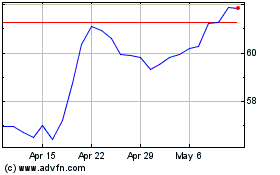By Ryan Tracy and Emily Glazer
This article is being republished as part of our daily
reproduction of WSJ.com articles that also appeared in the U.S.
print edition of The Wall Street Journal (February 5, 2018).
The Federal Reserve's unprecedented move to handcuff growth at
Wells Fargo & Co. sent a message that boards of directors, not
just management, will be held accountable when big banks fail to
manage risks.
The Fed on Friday said Wells Fargo would be replacing four board
directors in 2018 and announced an enforcement action that limits
the size of the third-largest U.S. bank by assets, potentially
crimping revenue and profit growth.
While directed at Wells Fargo, which has struggled to overcome
the sales practices scandal that engulfed the bank in September
2016, the Fed's action has wider ramifications.
"The Fed just put the fear of God into bank boardrooms across
the country," Ian Katz, an analyst at Capital Alpha Partners, said
in a note on Sunday. "And that's exactly what it wants to do."
The Fed, which cited "widespread consumer abuses" at Wells
Fargo, has never before imposed such a broad restriction as part of
an enforcement action. Wells Fargo is barred from growing past the
$1.95 trillion in assets it had at the end of 2017, unless it gets
regulators' permission. Fed officials did say the company can
continue to lend and take deposits.
Wells Fargo said it was "confident it will satisfy the
requirements of the consent order."
CEO Timothy Sloan, also a board director, said on a call with
analysts Friday evening that the bank within 60 days will submit
plans to the Fed "that leverage existing plans and efforts already
under way to further enhance the board's effectiveness in carrying
out its oversight and governance of the company and further improve
the firm-wide compliance and operational risk management
program."
A letter Friday from departing Fed Chairwoman Janet Yellen to
Sen. Elizabeth Warren (D., Mass.), showed that the central bank is
thinking more broadly than just Wells Fargo. Ms. Yellen wrote that
the Fed is raising expectations for boards of directors across the
banking industry.
The letter cited guidance for boards the Fed proposed in August,
which Mrs. Yellen wrote "marks the first time that the Federal
Reserve has issued stand-alone expectations for boards of directors
as distinct from management."
"That distinction allows us to spotlight the core
responsibilities of effective boards, one of which is to ensure the
independence and stature of the risk management and internal audit
function," the letter said.
Mrs. Yellen handed over leadership of the central bank this
weekend to Jerome Powell. He was appointed by President Donald
Trump, who has pushed a deregulatory agenda for banks and other
industries.
But banks shouldn't necessarily think Mr. Powell will change
course. As a Fed governor, he took a leading role in pushing the
Fed to adopt the new regulatory guidance for board members.
"Across a range of responsibilities, we simply expect much more
of boards of directors than ever before," Mr. Powell said in an
August 2017 speech, the month the draft guidance was published.
"There is no reason to expect that to change."
The Fed guidance, which applies to all banks, seeks to reduce
the number of regulatory requirements for which boards of directors
are directly accountable. Fed officials said the goal wasn't to
make boards' lives easier but to push the board to focus on
big-picture issues, such as firm-wide risk management.
The restriction on Wells Fargo's asset growth also took the Fed
into uncharted territory, and the harsh penalty reflected a
judgment that the bank's board failed to ensure "that senior
management had established and maintained an adequate risk
management framework commensurate with the size and complexity of
the firm," as the Fed's enforcement order put it.
During the financial crisis, the Fed and other banking
regulators indirectly pushed banks to add board directors with more
financial experience.
Wells Fargo had been an outlier in recent years among big banks,
expanding its footprint at a time when peers such as Citigroup Inc.
and Bank of America Corp. were largely retrenching as they
recovered from the 2008 financial crisis. For instance, regulators
didn't object to Wells Fargo acquiring or financing nearly $50
billion of General Electric Co.'s assets as it dismantled its GE
Capital lending unit around 2015.
More recently, as the bank's problems in different corners of
the firm continued to unfold, Fed officials concluded Wells Fargo
had grown and taken on more risk, without adequately updating its
ability to manage that risk. The firm's problems were so broad that
officials decided a broad punishment was warranted.
In September 2016, the bank settled allegations that it had
engaged in years of improper sales practices that resulted in
potentially 3.5 million accounts being opened without customers'
knowledge. Elsewhere, more than 550,000 auto-loan and mortgage
customers were possibly overcharged for products for years as
well.
Over the past year, and even before the Fed's action, Wells
Fargo had named six new directors, including three who joined in
January 2018. Three of Wells Fargo's current directors were
planning to retire by the end of the bank's annual shareholders
meeting, which typically occurs in late April, a person familiar
with the matter had said before the Fed penalty was announced
Friday.
Ms. Yellen said last fall the Fed was committed to taking action
against Wells Fargo, and negotiations on the terms intensified
during the past several weeks, people familiar with the matter
said. The main sticking points were the asset cap, the terms for
which the asset cap would be removed and the letter to Wells
Fargo's board of directors, these people said.
Write to Ryan Tracy at ryan.tracy@wsj.com and Emily Glazer at
emily.glazer@wsj.com
(END) Dow Jones Newswires
February 05, 2018 02:47 ET (07:47 GMT)
Copyright (c) 2018 Dow Jones & Company, Inc.
Wells Fargo (NYSE:WFC)
Historical Stock Chart
From Mar 2024 to Apr 2024

Wells Fargo (NYSE:WFC)
Historical Stock Chart
From Apr 2023 to Apr 2024
